Disinfection with UV Light, >99% Kill Rate for Viruses (incl COVID-19) or Bacteria
- By Ledrise Led Professional
- Jun 16, 2021

Effective and cost efficient disinfection or sterilizing of surfaces, water and objects has become of huge importance. The COVID-19 (coronavirus) pandemic made this extremely clear. In 2020 it created a extreme buying spree for everything that can be used in fighting it. Never before seen shortages of disinfectants, surgical masks, gloves, ventilators and more, happen all across the globe.
The situation is was made worse by the fact that many of the materials used for sterilisation are single use and have to be disposed afterwards. More have to constantly produced, exacerbating supply issues. It is time for a more efficient way of killing virus and bacteria, it is time for disinfection with UV light.
|
"UV light annihilates viruses and bacteria by destroying their ability to reproduce. " |
Using ultraviolet (UV) light to disinfect or sterilize1 has actually been embraced by some hospitals since years, by using large, industrial-grade machines to kill microorganisms (including COVID-19) in hospital rooms or on furniture, objects, clothing or instruments. However, such machines are prohibitively expensive for private or business use, as a mobile platform with UV lamps can cost more than 60.000 USD2. They are also dangerous for people and have to be used only in empty rooms.
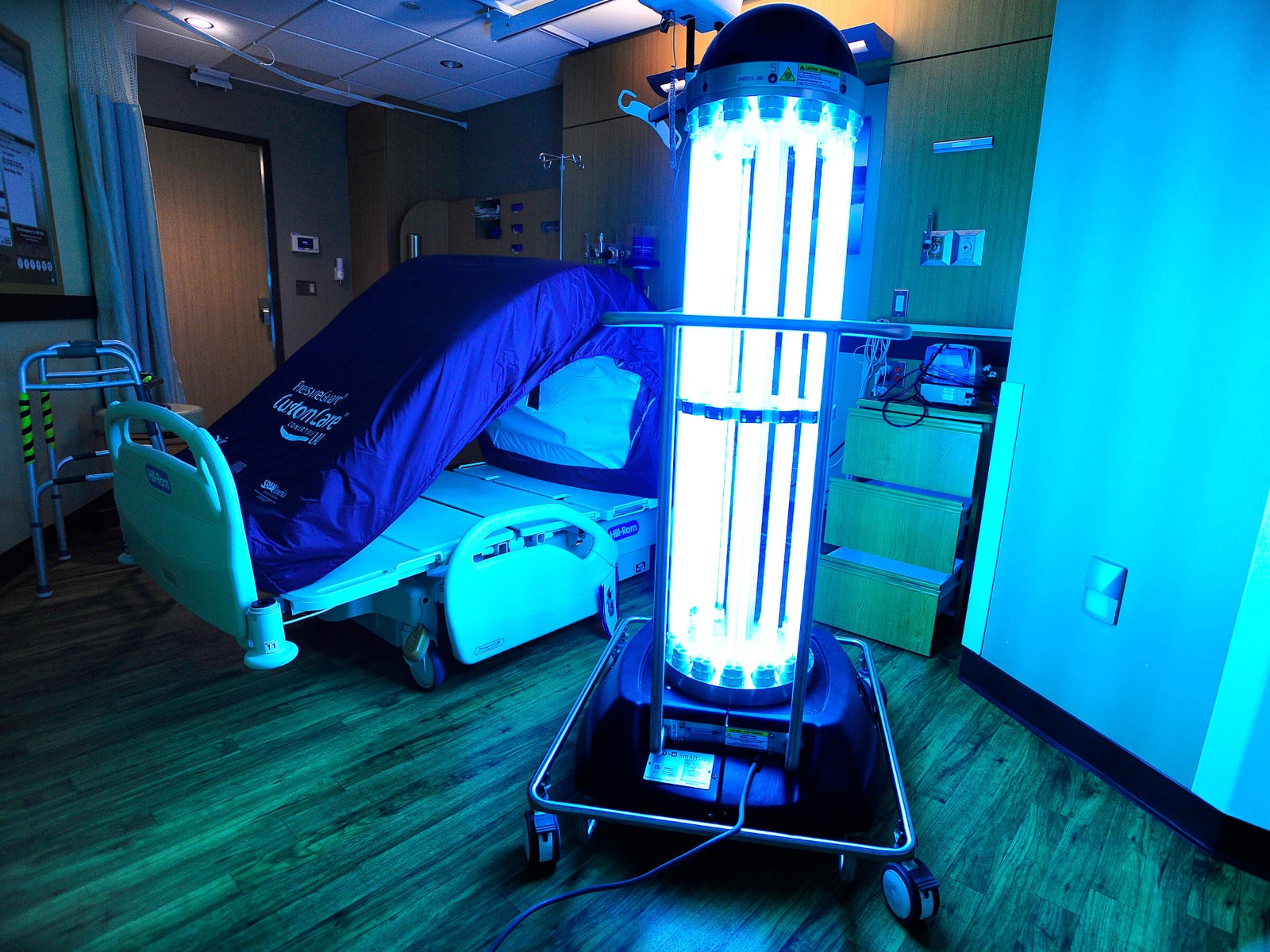
With the current advance in UV LED lighting technology, smaller versions of safe to use UV disinfection lamps can be made available to consumers and companies looking to clean pretty much everything, from office spaces, elevators and living rooms, to phones, computers and even toilet seats.
This widespread use of UV light to fight virus and bacteria can now happen with using the novel but efficient approach of continuous disinfection with low intensity UVA light from lighting emitting diodes (LEDs).
|
"Continuous disinfection: UVA radiation functioning for 8 hours, daily. Safe for people*. Will kill up to 99% of viruses and bacteria**. " |
*Irradiance limited to 10W/m2 at 2m from the floor.
**According to two independent studies quoted in this article.
How UV light kills viruses and bacteria

Bacteria are one-celled organisms that can be found naturally throughout our bodies and in our environment. Viruses are smaller than bacteria and they attach themselves to another living cell and use that cells' genetic material to reproduce themselves.
Well known dangerous bacteria are Salmonellae, Staphylococcus Aureus (MRSA) or E.coli. Most viruses cause disease, such as COVID-19, the flue, common cold, AIDS, chicken pox and much more.
While bacteria and viruses are clearly different, both have a very common attribute, they have genetic material (DNA).
Sunburns, that we have to protect from when out in the sun, happen because UV light damages the DNA. This is exactly why UV light kills all viruses and bacteria, it damages their DNA3.
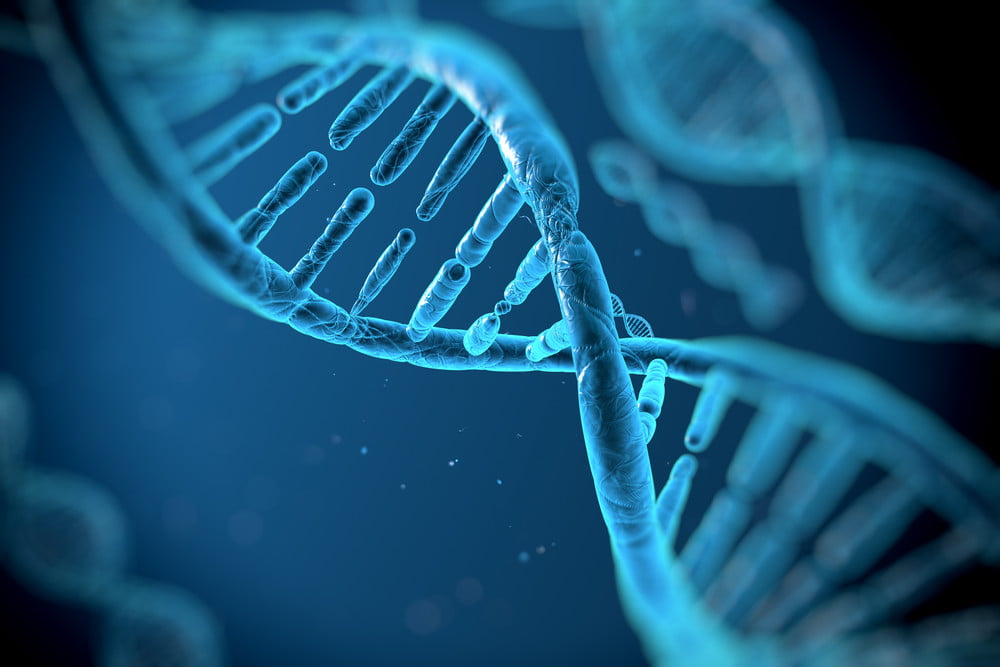
A DNA molecule is made of two strands bound together by four bases, adenine (A), cytosine (C), guanine (G), and thymine (T). These bases are like an alphabet, and their sequence forms instructions for cells to reproduce.
UV light can cause thymine bases to fuse together, scrambling the DNA sequence and essentially throwing a wrench into the replication machinery. Since the DNA sequence is no longer correct, it can no longer replicate properly. UV light annihilates viruses and bacteria by destroying their ability to reproduce.
Will it work on the coronavirus?
While COVID-19 is a new virus the major difference to others is that people do not have immunity to it as of yet. Exposed to UV light the COVID-19 will die just like any other virus. Studies on both SARS4 and MERS proved that UV light inactivates viruses, so it’s almost certain it will have a similar effect on COVID-19.
Types of UV radiation
UV is defined as electromagnetic radiation with a wavelength between 100 and 405 nm. Within this interval there are three subintervals that are very important to take into consideration: UVA, UVB and UVC.
According to CIE 1984, CIE 1987:
- UVA light has a wavelength from 315 to 400 nm
- UVB wavelength is from 280 to 315 nm
- UVC wavelength is from 100 to 280 nm
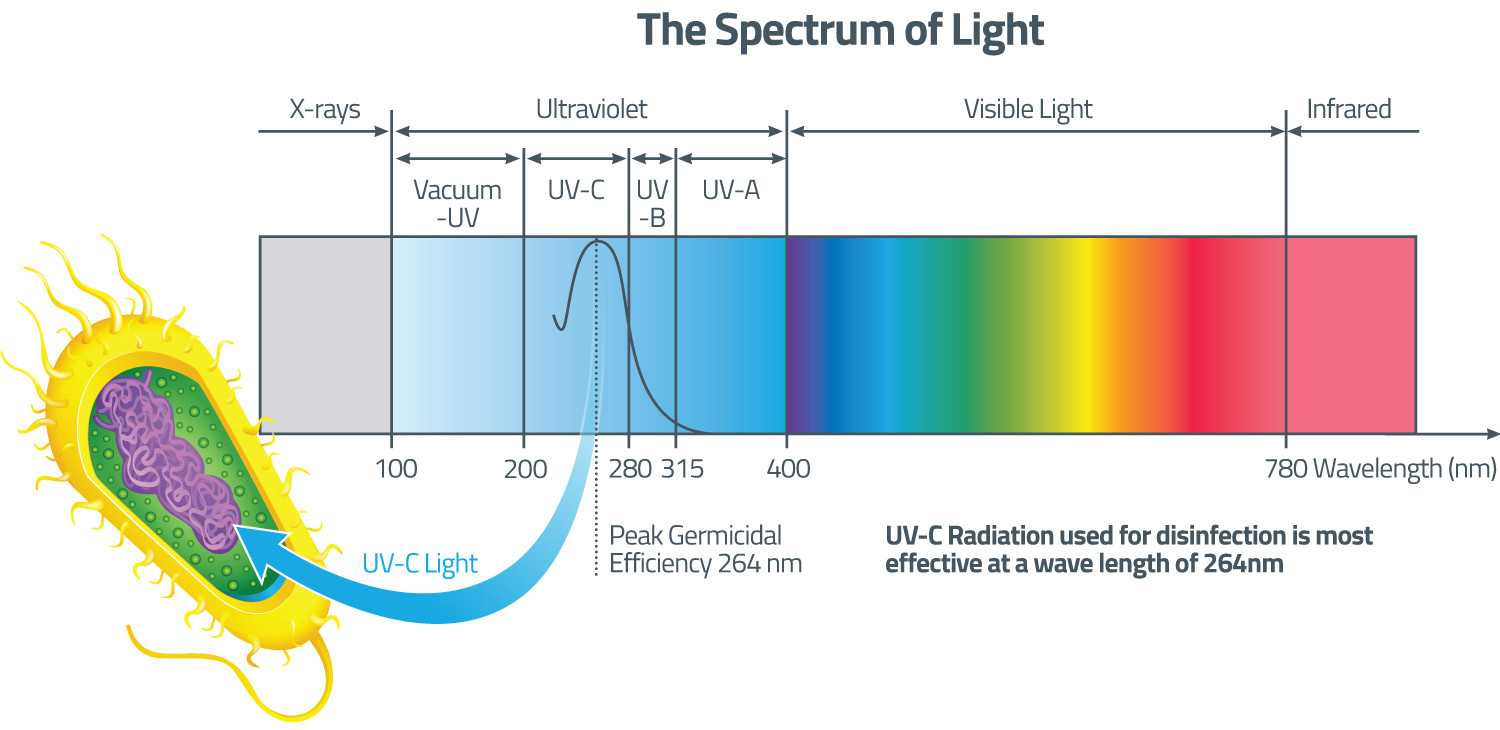 The time needed for UV to kill bacteria or viruses is depended on the radiation wavelength. UVC radiation will require the shortest time, as low a few seconds while UVA with the same irradiance will disinfect in minutes or hours.
The time needed for UV to kill bacteria or viruses is depended on the radiation wavelength. UVC radiation will require the shortest time, as low a few seconds while UVA with the same irradiance will disinfect in minutes or hours.
Unfortunately there is a direct relationship between the rapidity of the sterilisation or disinfection process and the danger to human health. According to international safety standards, such as EU-Directive-2006-25-EC, UVC radiation is the most dangerous, with maximum exposure (depending on wavelength and energy) of only a few seconds.
For this reason the deployment of UVC lamps is restricted to tightly controlled, professional use.
Germicidal UV Lamps explained
UV lamps have many applications so it should be made clear that those that kill viruses and bacteria are called Germicidal UV Lamps.
Currently on the market the most common types of Germicidal UV Lamps are Hg lamps with UVC radiation, in two versions: gas discharge lamps with low or medium pressure mercury (Hg) vapour.
|
"UVC is as dangerous to viruses as to humans, lamps with UVC radiation must be deployed with great care. Tiny doses can damage the skin or eyes. UVC lamps will never achieve the widespread use required to fight a pandemic. " |
Fluorescent tubes are available with UV light also and there are referred to as “black lights” but have other applications such as forensics, decorative light or “bug zappers”, depending on the wavelength peak. Some models of pressure lamps have the same format as T8 fluorescent tubes, which can lead to confusion about the type of lamp.
Hg lamps primarily emit UVC radiation at 254 nm. They reach high conversion efficiencies, up to 40%, from input electrical power, watts, to output UV radiation. However, these lamps are limited in their power density (maximum UV w/m2). The lamp housing is made of fused silica (quartz), a must for the necessary UV transmission and resistance to the high operating temperature. Because UVC radiation is blocked by plastics and also damaging to many materials, lamps must be used without cover, increasing the risk they break and cause mercury poisoning.
UVC radiation from our sun is blocked by the atmosphere so no living organism, including people, have protection from it. It is as dangerous to viruses as to humans, lamps with UVC radiation must be deployed with great care. Tiny doses can damage the skin or eyes.
|
"The major differences between germicidal Hg lamps and UV LEDs are the safety of their use and effectiveness of irradiating UV rays on the surface that needs to be disinfected. " |
All Hg lamps also have a broad spectrum, with peaks from 185 nm to 546 nm that makes them even more dangerous for people, which restricts the medical application even more.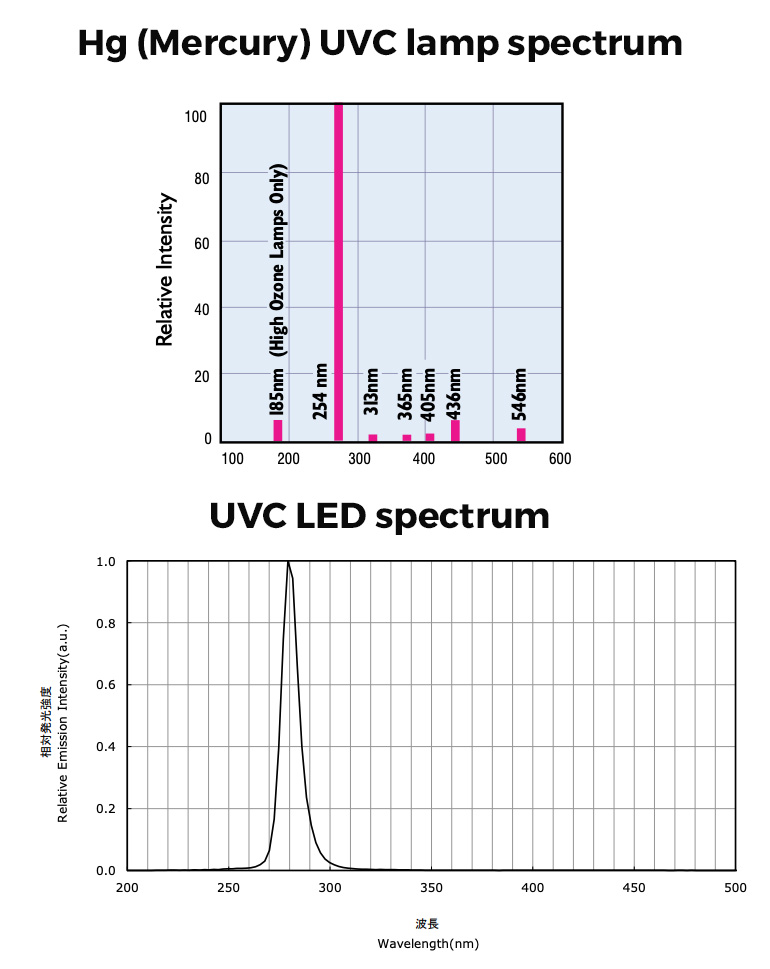
With such issues, UVC lamps will never achieve the widespread use required to fight a pandemic.
UV light emitting diodes are built to have narrow emission spectrums, such as 265nm, 280nm (see above), 365nm or 385 nm. This results in a much wider range of applications.
The main body of UV-LEDs consists of the semiconducting compounds GaN, InN and AlN and their mixed crystals. When electric current passes through specially doped layer sequences of these semiconductors, it is partially converted directly into UV radiation.
UV LEDs are very small and sturdy, have no heat in their UV beam and very little overall, so they can be grouped in high density arrays that can direct much more UV radiation to a surface, because of their viewing angle of only 120 degrees.
With the possibility to use high precision lens (up to 90% efficiency), a disinfection device with UVA LEDs can be more efficient at killing viruses and bacteria than Hg lamps of similar or even higher total UVC output. The UV output of a LED lamp can be also controlled by regulating the input current with a LED driver.
Hg lamps emit UV radiation in all directions, only up to 50% reach a flat surface where disinfection is required, such as a table. Their large dimensions and high operating temperature result in great difficulty of focusing this radiation with a reflector.
Germicidal action of UV radiation
The effectiveness of the sterilization or disinfection with UV light depends on the exposure, time, wavelength and irradiance6.
- Exposure or fluence (sometimes called dose) is measured in mJ/cm2 (where 1 mJ/cm2 = 10 J/m2.)
- Exposure time is measured in seconds (s), minutes (m) or hours (h)
- Irradiance is the flux of radiant energy per unit area, in other words how much of the UV radiation power (measured in W = 1000 “miliwatts” mW = 1.000.000,00 “microwatts” μW ) reaches the surface. Irradiance is measured in mW/cm2 or W/m2 (1 mW/cm2 = 10 W/m2) and is dependent on the radiant power, distance and dispersion of the radiation emitted by the lamp source.
Studies that show the effectiveness of UV light in disinfection or sterilization present in their findings the inactivation of virus or bacteria for a given Exposure in an amount of time, for a given UV wavelength.
The exposure (fluence or UV dose in mJ/cm2) is obtained by multiplying the Irradiance (fluence rate in mW/cm2") by the exposure time in seconds.
For example for a UV with a Irradiance of 3 W/m2 the exposure for one hour is 10800 J/m2.
The studies are the science behind the use of UV lamps for sterilization or disinfection. They are the reason why UVC lamps are used in the way they are, with powerful, short emissions in empty hospital rooms. Similarly, research presented in this article will bring forward the revolution of disinfection with UVA LEDs.
Germicidal action of UVC 200-280 nm for rapid disinfection and professional use
There are many studies 1,3,4,5 about the effectiveness of using UVC lamps for disinfection or sterilization, either with Hg lamps or LEDs. For example the results of such a study can be found below:

Lets explain briefly the link between dose, exposure time and irradiance. For a dose of 100 mJ/cm2 in a period of 5 seconds a 100 / 5 = 20 mW/cm2 irradiance is required. If the irradiance is higher, the required dose of 100 mJ/cm2 is reached in less time: at 200 mW/cm2 the time is only half a second, while for 4 mW/cm2 is 25 seconds.
As the research shows UVC in a hospital setting could quickly disinfect surfaces, even in a matter of seconds.
With the recent COVID-19 outbreak UVC lamps where deployed is many hospitals, in USA, China, Germany, France, Italy and more. From China the latest guideline on the diagnosis and treatment of the novel coronavirus released by the National Health Commission is recommending an irradiance of 1.5 watts per cubic meter to effectively eliminate the virus. A UVC lamp with this intensity can disinfect objects within one meter for at least half an hour.
Even with overwhelming evidence of their efficacy, devices with UVC Hg lamps for sterilisation and disinfection will remain rare because there are dangerous.
UVC LEDs have the potential to become widespread but the current technology limits their UV output power to less than 100 mW per LED. This limits their application to usage into compact professional devices for sterilisation or disinfection of small areas.
There is little hope for a revolution in UVC disinfection to happen any time soon. The revolution will come from UVA disinfection.
Germicidal action of UVA 365-380 nm for widespread disinfectionat affordable price
With the development of the first UVA LEDs in the 2000s, studies about the efficiency of 365 nm UVA LEDs in disinfection and sterilization have been made. They are the root of the continuous disinfection concept and summary of the results for several relevant studies is presented next.
|
"<10 min & 800mW: Complete germicidal effects of E.coli and Vibrio parahaemolyticus7" "<60 min & 800mW: Complete germicidal effects for Vibrio parahaemo-lyticus, Staphylococcus aureus, Salmonella enteritidis in water8" "<5 min & 250mW: 90% eradication of C. albicans and E.coli9" "<30 min & 1000mW: 99.9% eradication of Candida albicans and Escherichia coli10" "<60 min & 10mW+1.69mW: Complete germicidal effects of Mesophilic bacteria and Fecal enterococci in 500ml of water11"
|
1. The first was a 2007 study7 from Japan, that found that there are complete germicidal effects for E. coli and Vibrio parahaemolyticus by exposure at a 365nm UV-LED for a time of 30 minutes and 10 minutes, respectively. The conclusion came from experiments made with 8 Nichia UVA LEDs NCCU033(T) UV with a radiant power of only 100mW each.
2. The study was followed by research into sterilisation of water8, with the same 8 LEDs Nichia UVA LEDs NCCU033(T) of 100 mW. All bacteria, Vibrio parahaemo-lyticus, Staphylococcus aureus, Salmonella enteritidis, found in water was 100% eradicated in less than 60 minutes.
3. Evidence increased with another study in 20109. By using one Nichia NCSU033A(T) 365nm UV-LED with 250mW from distance of 2 cm the researches concluded that 90% of C. albicans and E.coli is effectively inactivated in under 5 minutes. In 60 minutes no trace of these bacteria was found (>99% kill rate).
4. Surface sterilisation (>99.9% kill rate) in less than 30 minutes was confirmed in another 2010 study10 with 4 x Nichia NCSU033A(T) 365nm UVA LEDs with a radiant power of 250mW each (1000mW). After only 5 minutes, 90% of microorganisms, (Candida albicans and Escherichia coli), where gone.
5. In a very interesting study11 from 2012, a combination of wavelengths from one 365nm, 10mW UVA LED and one 280 nm, 1.69 mW UVC LED, both from Seoul Semiconductor successfully disinfected of microorganisms 500 ml of waste water in under 60 minutes. Study was conducted on Mesophilic bacteria and Fecal enterococci.
These studies and others show that UVA radiation can also kill 99% of all bacteria or viruses (including COVID-19) with the condition of longer exposure or fluence than at UVC radiation.
All the above studies from 2007-2012 where conducted with UVA LEDs that irradiate the test surface or liquid from short distances. The research resulted in little practical applications because of the very limited UV power of LEDs available at the time.
By 2021 the UV power of UVA LEDs has increased exponentially:
- Today one NCSU033C LED from Nichia has a radiant power of up to 1500mW at 365nm for 6.8x6.8mm in size
- Nichia NVSU233B has 1450mW
- Nichia NVSU333B has 4900mW.
With their small size, UVA LEDs placed in linear modules, such as the NVSU233B PowerBar can reach more than 12000 mW of UV radiant power for only 28 cm of length.
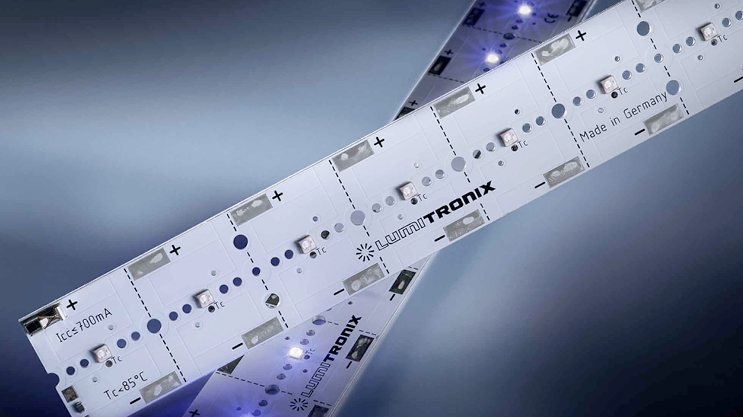
High levels of radiant power with narrow UVA spectrum, combined with the precision of optics technology and easy control out via current limitation makes continuous disinfection practical and easily achievable.
UVC LEDs also have seen progress, with typical radiant power at 50 to 100 mW, from LEDs such as Nichia NCSU334A (55 mW typical at 350mA). However, they still have too low radiant power for disinfection of rooms or even work surfaces. Possible applications for UVC LEDS are UV spotlight devices for disinfection at short distance or in fixtures in combination with UVA LEDs.
Continuous disinfection with UVA LEDs explained
The scientific basis of continuous disinfection comes from the fact that radiation at safe level for people can still kill viruses and bacteria.
|
“<8 hours & 3W/m2: up to 99% eradication of Staphylococcus aureus and Escherichia coli12” “<8 hours & 3W/m2: up to 99% eradication of Staphylococcus aureus (MRSA), Candia auris, virus Phi X174 ,virus MS-213” |
The safe levels of UVA radiation are found in the IEC Standard 62471:2006, ‘Photobiological Safety of Lamps and Lamp Systems’ that gives safety thresholds for near-UV (UV-A; 315–400 nm), far-UV (actinic; 200–400 nm), and blue light (300–700 nm). According to the standard, exposure at near-UV radiation, including 365nm, on the skin or at the eyes is safe for a period of up to 8 hours if the irradiance is limited to 10 W/m2. For far UV, the safe actinic-weighted irradiance limit is only 0.001 W/m2, also for 8 hours on the skin or at the corneas.
|
A system for continuous disinfection can be easily build with 365nm UVA LEDs that respect the 10 W/m2 safety threshold and function for a maximum of 8 hours per day. Example: 365 nm UVA LEDs with 40W radiant power are placed inside a luminaire at room height of 2.5m and function 8 hours per day. The UVA radiation at 1.9m from the floor (height of a typical tall person) will be less than the 10 W/ m2, below the safety threshold for exposure up to 8 hours per day. The UVA LEDS will disinfect the work areas at 80-100 cm from the floor with irradiance of approximately 3 W/m2 , which has been proven to be effective to kill up to 99% of virus and bacteria.
|
The continuous disinfection with 3 W/m2 irradiance from 365nm UVA LEDs has been proven to be effective, safe and easy to implement in a 2019 study12 published in the academic journal Lighting Research & Technology in the USA. The research found that the exposure to 365nm UVA radiation of only 3W/m2 at workplace height for 8 hours each day is safe for humans but will kill pathogens.
At the Memorial Beacon Children’s Hospital in South Bend, Indiana, USA, UVA LEDs where installed in ceiling luminaires in patient rooms and functioned 8 hours per day with a irradiance of 3W/ m2 at workplace height. The UVA light was directed at the sink and counter areas, where the highest risk of infection exists. Effectiveness of continuous disinfection was tested in these areas. Results show a reduction of up to 98% of the pathogens such Staphylococcus aureus and Escherichia coli.
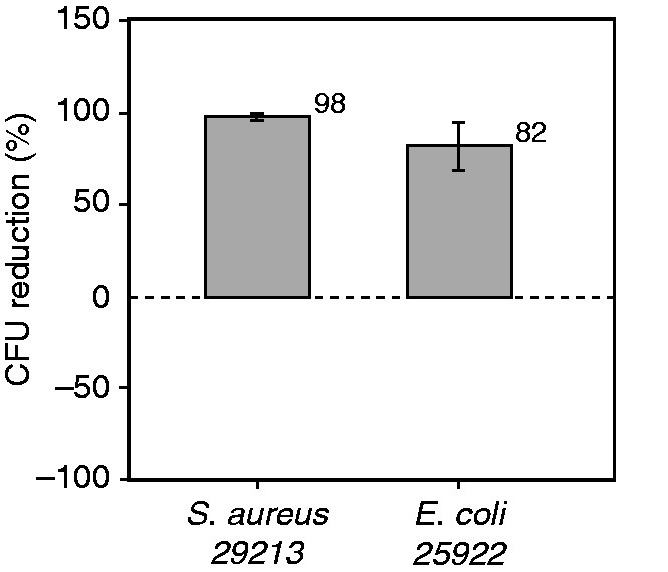 A follow up study in a 2020 edition of the the American Journal of Infection Control13 found similar results of reduction from 3W/ m2 irradiance on the presences of pathogens such as methicillin-resistant Staphylococcus aureus (MRSA), Candia auris, the enveloped virus bacteriophage Phi X174(ATCC 13706-B1) and the nonenveloped virus bacteriophage MS-2(ATCC 15597-B1).
A follow up study in a 2020 edition of the the American Journal of Infection Control13 found similar results of reduction from 3W/ m2 irradiance on the presences of pathogens such as methicillin-resistant Staphylococcus aureus (MRSA), Candia auris, the enveloped virus bacteriophage Phi X174(ATCC 13706-B1) and the nonenveloped virus bacteriophage MS-2(ATCC 15597-B1).
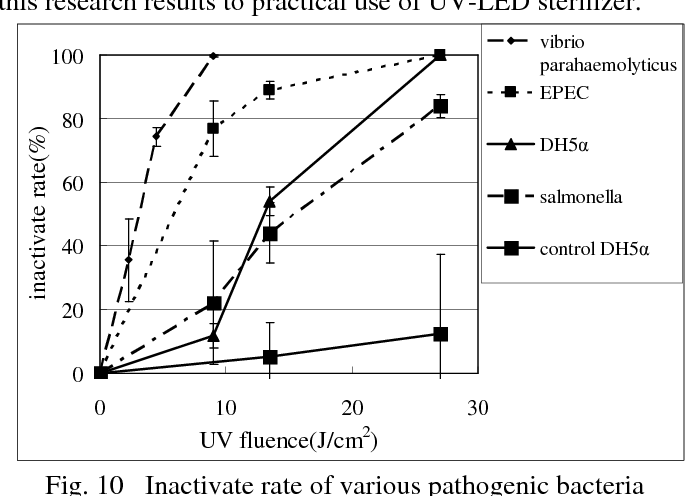
The possibilities to use UV LEDs for disinfection or sterilisation are vast, as these studies show. Continuous disinfection with less than 10W/m2 with 365nm UVC LED light fixtures, faster disinfection with higher but controlled amounts from of UVC or UVA LEDs, or a combination of both are just some of the possibilities. More research about effectiveness should also be made so these methods can become standard, recommended, medical practice.
Continuous disinfection with near-UVA 405nm violet LEDs
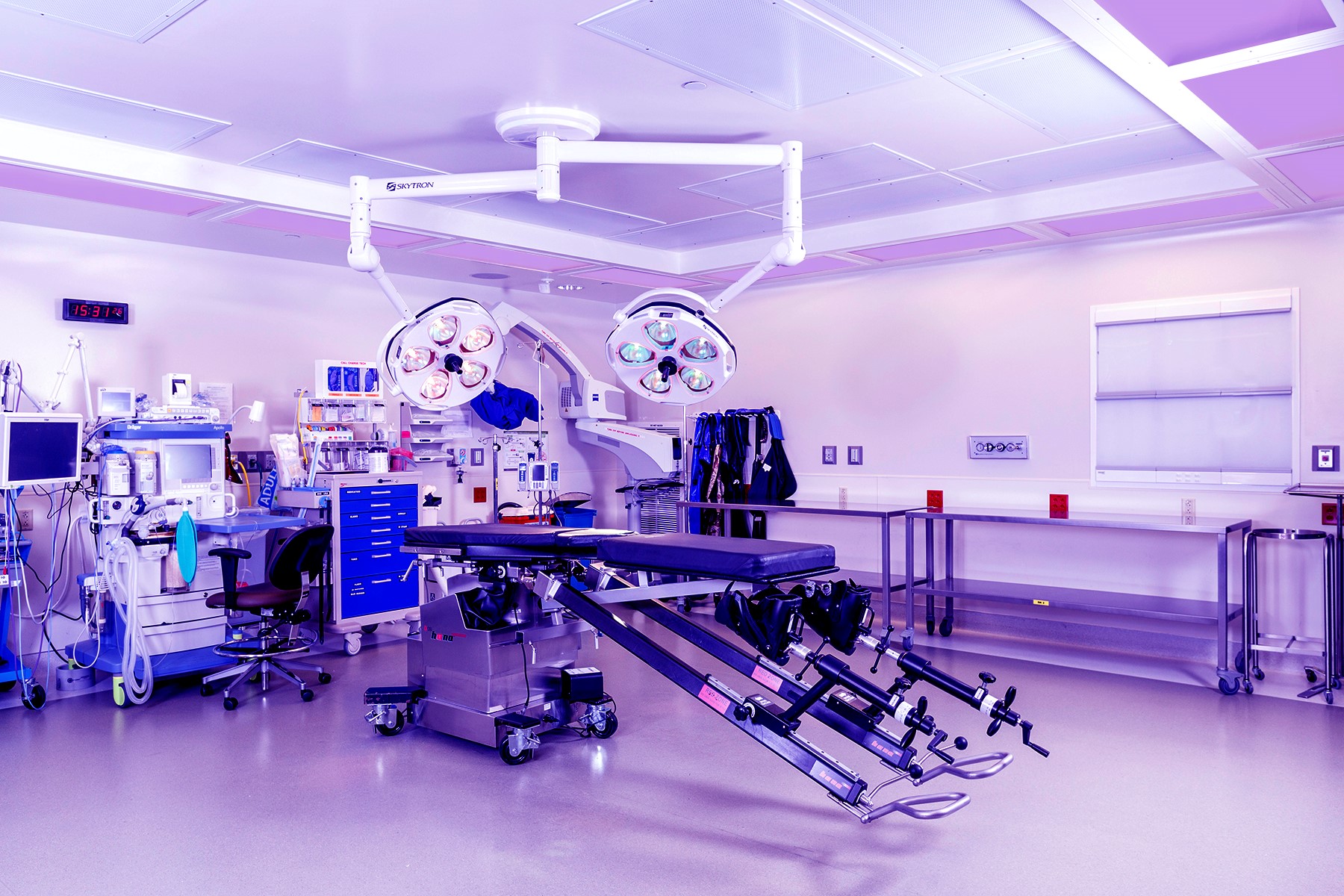 A ceiling-mounted lighting system measuring 2 ft x 4 ft with 405nm violet LEDs where installed in two operating rooms (ORs), with an irradiance level of 5-6 W/m2 (0.498 mW/cm2 to 0.558 mW/cm2) at workplace level15. While violet light is much safer than UVA, it is visible light that impacts the color redention of the lighting installation, thus the violet LEDs only functioned when the rooms where not in use.
A ceiling-mounted lighting system measuring 2 ft x 4 ft with 405nm violet LEDs where installed in two operating rooms (ORs), with an irradiance level of 5-6 W/m2 (0.498 mW/cm2 to 0.558 mW/cm2) at workplace level15. While violet light is much safer than UVA, it is visible light that impacts the color redention of the lighting installation, thus the violet LEDs only functioned when the rooms where not in use.
The study focused on measuring the infections in the two ORs between the previous period when manual cleaning was used to the current period, with augmented disinfection with the violet light 405nm system. A statistically significant reduction was discovered, with only 3 infections compared to an anticipated 12 infections that resulted from a prediction based on the previous period. A potential 9 infections were prevented.
The results where so promising that lighting systems with violet LEDs for continuous disinfection are already installed in operating rooms in more than 20 hospitals across the USA16.
Soon disinfection with UVA or violet light could see widespread use in many homes, offices, commercial space, public transport vehicles and even streets.
The dangerous UVC Hg lamps will still remain limited to narrow professionals applications primarily in health care.
This new UV LED revolution can start with the current COVID-19 pandemic. It should to, as it will be the best weapon to fight the next one, that might be even more deadly.
References:
- Far-UVC light: A new tool to control the spread of airborne-mediated microbial diseases: https://www.nature.com/articles/s41598-018-21058-w
- News article Coronavirus: Robots use light beams to zap hospital viruses https://www.bbc.com/news/business-51914722
- Predicted Inactivation of Viruses of Relevance to Biodefense by Solar Radiation https://www.ncbi.nlm.nih.gov/pubmed/14631830
- Stability of SARS coronavirus in human specimens and environment and its sensitivity to heating and UV irradiation. https://www.ncbi.nlm.nih.gov/pmc/articles/PMC1280232/
- Inactivation of Middle East respiratory syndrome coronavirus (MERS-CoV) in plasma products using a riboflavin-based and ultraviolet light-based photochemical treatment. https://www.ncbi.nlm.nih.gov/pubmed/27805261
- UV Faq: http://www.iuva.org/UV-FAQs
- Sterilization Using 365 nm UV-LED https://www.semanticscholar.org/paper/Sterilization-Using-365-nm-UV-LED-Yagi-Mori/ee8484bf684b2077358508df00e9a42289f9f09f
- New water disinfection system using UVA light-emitting diodes https://sfamjournals.onlinelibrary.wiley.com/doi/pdf/10.1111/j.1365-2672.2007.03464.x
- Development of a new water sterilization device with a 365 nm UV-LED https://www.researchgate.net/publication/5867444_Development_of_a_new_water_sterilization_device_with_a_365_nm_UV-LED
- Enhanced germicidal effects of pulsed UV-LED irradiation on biofilm https://sfamjournals.onlinelibrary.wiley.com/doi/pdf/10.1111/j.1365-2672.2010.04850.x
- Effect of coupled UV-A and UV-C LEDs on both microbiological and chemical pollution of urban wastewaters https://hal.archives-ouvertes.fr/hal-02069416/file/CHE%20HAL%202%20OK.pdf
- An assessment of a hybrid lighting system that employs ultraviolet-A for mitigating healthcare-associated infections in a newborn intensive care unit https://journals.sagepub.com/doi/full/10.1177/1477153520904107
- American Journal of Infection Control Efficacy of an ultraviolet-A lighting system for continuous decontamination of health care−associated pathogens on surfaces https://www.ajicjournal.org/article/S0196-6553(19)30746-1/pdf
- Influence of a visible-light continuous environmental disinfection system on microbial contamination and surgical site infections in an orthopedic operating room https://www.ajicjournal.org/article/S0196-6553(18)31146-5/pdf
- Shining a light on continuous disinfection: https://indigo-clean.com/assets/pdfs/Shining-a-Light-on-Continuous-Disinfection_CRTM_June-2018.pdf
- Website of manufacturer of violet light continuous disinfection system https://indigo-clean.com/who-is-using-it.php
Disclaimer: This article is for informative purpose only. The accuracy of the facts, findings an results presented are as good as the research results that are quoted above and the understanding of the author. Ledrise, nor the author of this article, are to be held responsible for the results of using UV disinfection/ sterilization based on information in this article.
If there are inaccuracies in this article there are solely by error. We appreciate all feedback in this matter.







